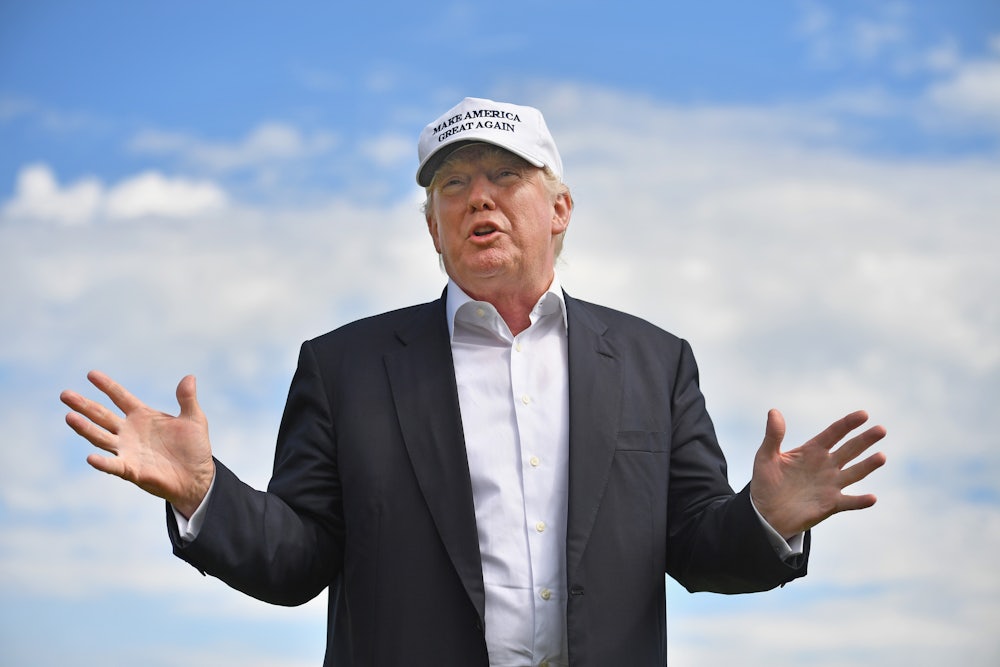“I want to say something to my Congress,” says an older man in a bright blue golfing shirt. “I’ve been a Republican all my life. I get party loyalty,” another adds, leaning against the porch of his house. Other voters start appearing on screen and chime in: “The things Donald Trump says about immigrants and women, veterans. I mean how can we put up with that? How can Republican members of Congress support that?”
The Democratic Congressional Campaign Committee is spending seven figures to run this ad, which is called “Standards,” and another one called “Sidekick” on cable and online starting Monday, singling out ten House districts with vulnerable Republican incumbents. This is its opening salvo in what is shaping up to be a concerted push through the fall to yoke endangered House Republicans to the deeply unpopular Republican nominee, in the hope that it will turn the rank and file away from the polls and bring the Democrats a little closer to regaining control of the House.
To fully understand
what the DCCC is hoping to achieve with these two ads, you have to look at the
geography in play. According to The Washington
Post, the committee
has chosen to target:
- Steve Knight, who represents a solid Republican district north of Los Angeles that covers towns like Simi Valley
- Mike Coffman, who represents the Denver suburbs
- John Mica from the district north of Orlando that includes affluent Florida suburbs like Winter Park
- Carlos Curbelo, who hails from the Cuban area at the southern tip of Florida
- David Young, who comes from the urban area covering Des Moines and its southwestern environs
- Bob Dold from the northern suburbs of Chicago
- Erik Paulsen of the Minneapolis suburbs
- John Katko from a swing district bordering Lake Ontario in upstate New York
- Will Hurd, who represents the largely Hispanic district that stretches along Texas’s southern border from Al Paso to San Antonio
- Barbara Comstock of the Washington exurbs that cover much of Northern Virginia
Many of these lawmakers represent key swing states like Florida, Virginia, and Colorado, where the message the DCCC is touting in its most recent ads may help Democratic nominee Hillary Clinton pull off a win in the general election this fall. But more importantly, the DCCC seems to be banking on the idea that well-educated suburban areas are the key to flipping the House.
Most of these districts cover suburbs that have reliably voted Republican in the past, but Donald Trump could shift the normal calculus there. Take Coffman’s Colorado district, which has sent a Republican to Congress every election cycle since 1982. In recent years, the Republican lock on the region has shown signs of breaking down. After redistricting in 2012, the district voted for a Democratic presidential nominee, Barack Obama, for the first time in recent memory. Voters there will likely identify with the people the DCCC spotlights in its most recent ad: traditional Republican voters who are willing to put country over party and who are uncomfortable with Trump’s more outlandish comments.
Had Marco Rubio or Jeb Bush been the Republican nominee, the DCCC may not have tried to use the presidential race to flip that kind of district. Rubio, in particular, is popular in suburban areas. Before January’s Iowa caucuses, he spent so much time campaigning in Des Moines suburbs that locals started calling him the Mayor of Ankeny, a suburb north of Des Moines. His Super Tuesday strategy likewise hinged on strong support in the suburbs of Atlanta, Minneapolis, and Washington, D.C. Now, however, with Donald Trump the nominee, huge numbers of affluent, educated, normally Republican voters may be ripe for the picking.
Whether House Democrats will be successful in turning widespread distaste for the real estate mogul into successes down-ballot is separate question. Many of the Republicans on this list have bent over backwards to distance themselves from the inflammatory Republican nominee. According to the Post, Knight, Dold, and Comstock have refused to back Trump. They are not planning on attending the Republican National Convention later this month. But it remains to be seen whether that will be enough to insulate them from the DCCC’s attempts to tie them to Trump.
The Republicans do have one advantage. Unlike Trump, who is only now starting to make headway in the fundraising game, collecting $51 million through direct solicitations and RNC events in June, these Republican incumbents have been fundraising for months and now have war chests large enough to counter a Democratic assault. According to FEC filings, Coffman, for example, had almost $1.4 million in cash on hand at last report, a respectable haul for a congressional race at this stage.
Furthermore, as David Dayen pointed out in The New Republic in March, Democrats have a weak bench lined up to challenge some of these Republican incumbents. In the same California district where the DCCC is now running ads aimed at hurting Republican incumbent Steve Knight, the local Democratic contender, Lou Vince, had trouble raising funds in his primary. Late in the game, national Democrats subbed in attorney Bryan Caforio, a Yale graduate who only recently moved to the district from Los Angeles, upsetting local activists.
Without a strong bench of challengers in these key districts, the opening Trump created this year for the Democrats may go to waste.
